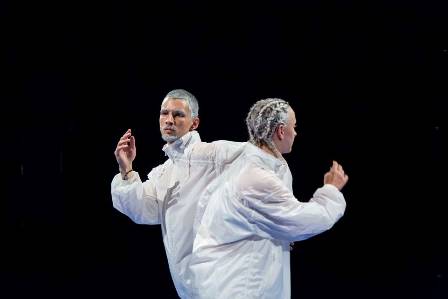30 April 2014, Courtyard Theatre, Canberra
James Batchelor’s Island is a fascinating look at what dance can encompass when it becomes an immersive experience. The work is performed by three dancers, Batchelor himself along with Amber McCartney and Rebecca Lee, and it deals largely with perception. I have to admit to feeling slightly frustrated by dance that purports to deal with highly abstract notions. Often it’s only the words on the program that have anything to say on the subject while the dance is just a series of steps. But Island is different.

The first hint that Island might be an interesting work comes early, as we enter the performing space in fact. Architect Ella Leoncio is the designer. She has decorated the small black box space that is the Courtyard Theatre of the Canberra Theatre Centre with bright white tape stretched in lines and geometric patterns across the floor and up the walls. A bank of mirrors is attached to one wall, six movable glass (or perspex?) screens are arranged in the centre of the space in two groups of three and six circles of small bright lights are on the floor. What we don’t know immediately is that some of the screens are slightly convex/concave, a little like those Coney Island-style mirrors that distort the image of those who look into them.
The work itself is in three parts performed without interval. It begins with a solo for Lee, which is followed by a duet for Batchelor and McCartney. All three dancers join together for the final section. Batchelor’s choreography exists in many small movements, sometimes quite subtle, other times forceful in response to Morgan Hickinbotham’s score, which is confronting and yet listenable in its diversity of sounds. I especially enjoyed the performance of McCartney who had absorbed Batchelor’s movement style and added something of her own—a strength of purpose perhaps? Her dancing was certainly strong and well-defined.
But what makes Island so interesting is that the audience is encouraged to walk around the space and see the dance/installation from different viewpoints. Again this is something that I usually find annoying as it is more often than not a meaningless exercise. On this occasion however, the mirrors and screens, which were moved into different positions at the end of each section, came into their own. There were some totally absorbing perspectives on Batchelor’s choreography. Depending on where one went it looked enlarged, minimised, stretched out, and any other number of shape distortions. Occasionally Leoncio’s striped walls and floor became an integral part of the dance when they too were reflected into the screens. Then as a foil there was the clean, precise look of dance undistorted when one moved to other positions. Not everyone in the audience was on the move, which was a real shame because they missed a lot.
Leoncio continued her black and white theme in her costumes and make-up with the white extending beyond the costumes themselves to hair, face and even fingernails in some cases.
I really enjoyed this show. Batchelor has an enquiring mind and his work is definitely worth looking at and analysing.
Michelle Potter, 3 May 2014
2 thoughts on “Island. James Batchelor”